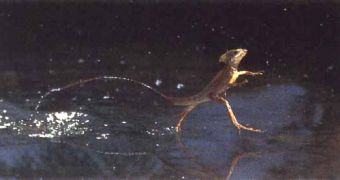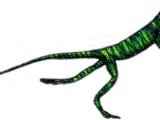Bipedalism is a term coming from "walking on two feet" in Latin. Humans are practically the only bipedal mammals. Kangaroos and many rodent species hop on two feet but they cannot walk. When walking, they do it on all four. Other species, like apes, monkeys and bears, may attempt walking on two feet, but they do it only for short distances. Their anatomy is not adapted for this.
Instead, all birds are bipedal. In fact, walking on two feet released their fore limbs for the function of flight, the way bipedalism released our hands for accomplishing complex functions.
Nevertheless, bipedalism is a characteristic well present in the birds' ancestors, the dinosaurs. There are no fossil records or present species of bipedal amphibians, but the fossil bipedal reptiles abound.
All basal dinosaurs were bipedal, and those that lost bipedalism (like the sauropod, Triceratops, Stegosaurus) evolved from bipedal species. The most primitive crocodiles were bipedal as well (even today, alligators and crocodiles have more developed rear limbs than fore limbs).
Amongst living reptiles, some lizards are known to practice bipedalism on short distances. In this case, they greatly increase their speed, in order to escape predators. The most famous occasionally bipedal lizards are some iguanas and agamid lizards.
The most famous temporary bipedal iguanas are the basilisks (Basiliscus) of Central America, which can even run on two legs onto the water, but also many iguana species of the southwestern US can run on two. Amongst agamid lizards, the most famous species that run on two is the frilled lizard (Chlamydosaurus) of northern Australia.
In 1993, researchers found, in Germany, the oldest known fossil of a bipedal reptile, predating the first dinosaurs by at least 60 million years. The 290-million-year-old reptile (from the Permian period) had a tail more than doubling its body length. Eudibamus cursoris, a bolosaurid (one of the first reptile groups, their closest living relatives (but by far) being ... the turtles!), was 25 to 30 cm (10-12 in) long and was a herbivore, escaping predators due to its bipedal ability, just like modern lizards. The hind legs were twice longer that the front limbs.
Bipedalism and energy consumption
When humans stopped using their hands for walking, everything they did was better, from foraging to sex. But a 2007 research showed that they did it because walking on two feet is less exhausting than "knuckle-walking" on all four, like chimps and gorillas do. Humans walking on two legs waste just a quarter of the energy consumed by chimps for walking around, as revealed by treadmill tests. Saving energy through bipedalism (walking upright) was a great advantage when competing for resources.
Chimps appeared to employ the same energy amount by walking on two legs as on four. Chimps performed differently linked to the length of their stride and the muscle amount employed with each step. Biomechanical equations say that energy consumption rises with shorter steps or more active muscle mass. Humans got their economic gait through relatively long legs and modified pelvic structures.

 14 DAY TRIAL //
14 DAY TRIAL // 
